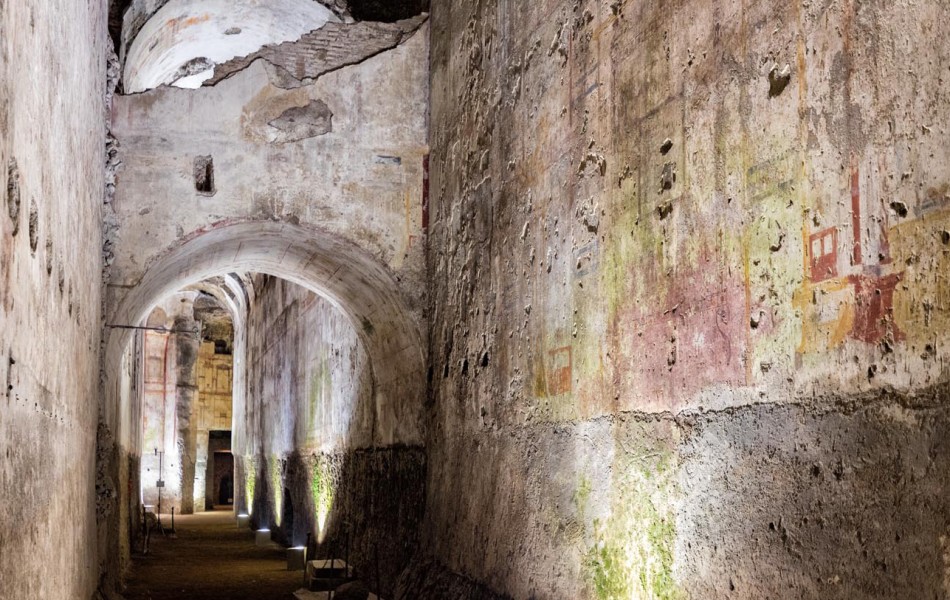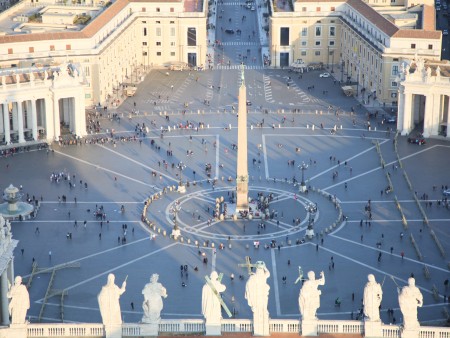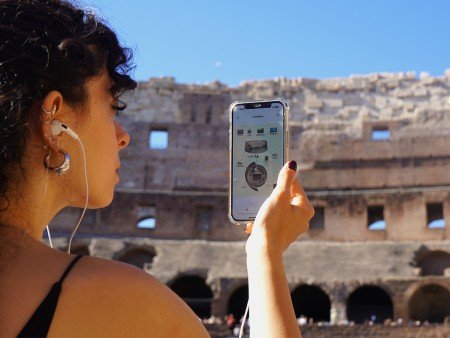The Pageantry of Nero and the frescoes in his Imperial Palace: The Domus Aurea
The extraordinary story of Nero's Domus Aurea: from imperial excess to Renaissance rediscovery

01 October 2024
Rome Travel GuideNero’s Golden Dream Palace
Nero’s Domus Aurea or Golden House, is a testament to the extravagant lifestyle of one of Rome’s most infamous emperors. Built in the aftermath of the Great Fire of Rome in 64 AD, this colossal palace replaced a significant portion of the city, showcasing Nero’s enormous power and wealth. The name Golden House is no exaggeration, as the palace was adorned with gold, precious stones, and opulent decorations.
When Nero became emperor he moved into a large palace on the Palatine Hill in the center of the most powerful empire in the world. Nevertheless he wasn’t satisfied and wanted more. More gardens, more buildings, more statues and most of all more space. The problem was at the time Rome was a city of over a million inhabitants and there was very little room left in the city to expand the house of the Emperor. Fortunately for Nero accidents happened and one of the most common accidents of the time was fire. Citizens relied on oil lamps and these oil lamps were very often the source of huge blazes that devastated the city. One such blaze provided the means for Nero to realise his dream palace.
Construction of Nero’s Golden House
In 64 AD a fire started that was unlike any the city had ever seen. It lasted 6 days and 6 nights and although Nero was blamed for the disaster that decimated over a third of the city there is no evidence he was responsible. He was good however at spotting an opportunity and once the fire was brought under control and the ruins cleared he quickly ordered two architects to begin work on a vast complex that included his Golden House.
House is an understatement for the complex that was built encompassed over 300 football fields of gardens, palaces, a lake and 40-foot Statue of Nero. Work progressed quickly and within four years Nero’s Golden House was nearly complete. The Domus Aurea was located on the Esquiline Hill and was the part of the huge complex where the emperor intended to entertain himself and his guests. Inside the villa there were no bedrooms or kitchens only the most lavish frescoes, sculptures and of course the gold for which Nero’s Golden House is named and which was meant to reflect the glory of its powerful resident.
You can join us to visit the House of the Emperor on ours Domus Aurea Tour.
A Buried Palace
The Golden House was more than a mere display of wealth. It was a bold assertion of Nero’s imperial authority, a physical manifestation of his desire to reshape Rome in his image. The palace’s immense scale and extravagant features served to both awe and intimidate the Roman populace, reinforcing Nero’s absolute power. Unfortunately, this display of grandeur contributed to growing resentment towards the emperor, ultimately leading to his downfall and the subsequent neglect of his monumental palace.
Nero, in fact, never had a chance to enjoy his Golden House. As the villa neared completion in 68 AD the emperor suffered a severe loss in popularity and succumbed to enemies who resented him and eventually overthrew him. Once they did it became clear that the maintaining Nero’s Golden House would be extremely expensive and unpopular with the people of Rome. So instead of maintaining the complex the emperors who followed dismantled it. The lake was drained and Vespasian began construction of the Colosseum, the gigantic bronze statue was refigured in the likeness of another emperor and the the Golden House was stripped of all valuables. Nero himself was declared a persona non grata and his memory wiped from the history books.
Following Nero’s dramatic demise, subsequent emperors, horrified by the palace’s excess, ordered its demolition. Over the centuries, the once-glorious structure was buried beneath layers of earth and rubble, becoming a forgotten legend. It wasn't until the Renaissance that this subterranean treasure was rediscovered, sparking a renewed fascination with Nero and his opulent tastes in architecture.
Ruin and Rediscovery of the Golden Palace
Destroying an emporer’s memory in antiquity meant destroying everything he had built and in Nero’s case that meant his Golden House. It was too immense to upkeep and extremely unpopular with the people who had been displaced in order for it to be built. The palace was sacked, valuable sculptures were removed and used to decorate other houses. The complex was gradually filled in with ruble and became the foundation for a bathing complex which Emperor Trajan had built on top of the building.
Over the centuries it was forgotten and after the decline of Rome would have remained hidden had it not been accidentally rediscovered by a passing shepherd who fell through the ancient roof and made an astounding discover that had a significant impact on the Renaissance. The importance of the discovery was immediately evident to the Pope and artists of the caliber of Raphael and Michelangelo who visited the site to view the colourful frescoes unlike any they had ever seen. They copied, they studied and they reinterpreted ancient artists thus merging their skills with ancient aesthetics and founding a Neo-classical movement. The underground area was slowly cleared and generations of archeologists began preserving and studying a building which had laid undisturbed for centuries.
Today Nero’s Golden House is as popular as it was during the days of the Grand Tour when the likes of Stendhal and Goethe gazed upon its pristine frescoes. Visitors can follow in these esteemed footsteps and discover a sight which was recently reopened and now provides an explanatory film, VR recreation of the villa and visit to some of itss most inspiring rooms including the oculus hall which may have inspired the Pantheon and provides an idea of the grandness Nero had in mind when he originally ordered the palace constructed.
The Domus Aurea stands as a unique and enduring testament to Roman opulence and engineering. While much of its original splendor has been lost to time, the surviving area offers a tantalizing glimpse into the mind of an emperor obsessed with power and excess. It is a place where history, art, and archaeology intertwine, inviting visitors to ponder the complexities of an ancient era.
Our categories:
You may also be interested ...

Vatican Private Tour with Sistine Chapel & St. Peter's Basilica: Renaissance’s Wonders
Private tour
Discover with a skip the line Private Vatican Tour the Sistine Chapel, Vatican Museums and St Peter’s Basilica
starting from: € 375

Colosseum Guided Audio Tour with Roman Forum and Palatine Hill
Private tour
Discover Ancient Rome’s secrets and history with our immersive Colosseum guided audio tour, rich in image and content
starting from: € 51 € 42